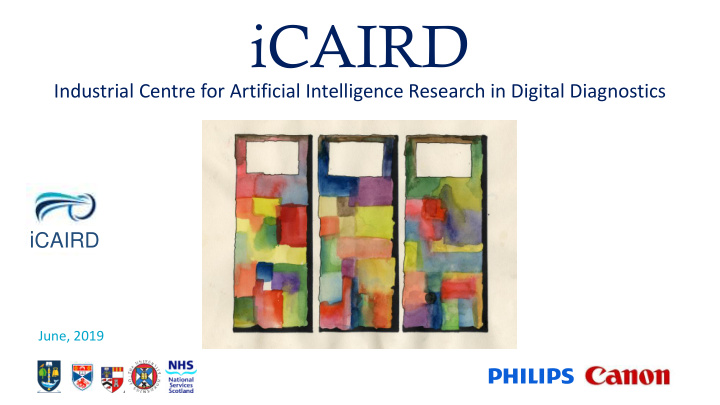



iCAIRD Industrial Centre for Artificial Intelligence Research in Digital Diagnostics i CAIRD June, 2019
Alison Murray Professor of Radiology, Director of Cambridge, MA SINAPSE, University of Aberdeen, NHS Grampian Peter Hamilton Leader Image Analytics, Philips Digital Pathology Solutions, Hon Professor of Imaging Centre Tissue Imaging, QUB, Belfast of Excellence Andy Smout Vice President Research, Canon Medical, Edinburgh Key features • Tried & tested partnerships Colin McCowan • NHS NSS Board Professor of Health Informatics, Santa Clara, CA University of Glasgow and Glasgow • Safe havens & HDRUK Safe Haven • SINAPSE David Harrison • National PACS NHS Lothian • Direct link to clinicians & Universities of St Andrews, Edinburgh & Glasgow 2
Democratising AI: Reducing Barriers to Entry 1. The Domain Barrier Without an existing product line and an established clinical collaborator network it is hard for SMEs to know where to focus 2. The Data and Annotation Barrier Machine learning solutions require huge amounts of data to generalise well. It is hard for SMEs to get access to that scale of data and harder still to annotate it accurately 3. The Clinical Validation Barrier Without a product already integrated into the clinical workflow it is difficult for SMEs to validate algorithms in a real- world multi-centre setting and generate the evidence needed to demonstrate their clinical effectiveness 4. The Regulatory Barrier Healthcare AI has stringent requirements on safety and effectiveness. These can daunt SMEs wanting to enter the market 5. The Channel to Market Barrier Without an established global sales and marketing organisation it is difficult for SMEs to access a large enough customer base, and without an established reputation it is equally hard to form commercial partnerships with established vendors 3
The Safe Haven AI Platform (SHAIP) Healthcare Enterprise Technology Company 1: Researcher works with Clinician to Clinician 2: Clinician identifies a suitable identify a potential new AI algorithm cohort of patients for research Researcher Data Controller Anonymizing 4: Data controller 3: Caldicott guardians approve use of Data Portal allocates cohort to data from cohort for specified research 6: Researcher uses anonymizing data company workspace portal to explore data and generate ground truth without encountering PHI Data Scientist WORKSPACE Caldicott 7: Data scientist uses machine learning portal to train new algorithm 5: Data approved for research is pulled from clinical systems and cached in the workspace Machine Algorithm Safe Haven Learning Portal 4
Philips-centric pathology AI Exemplars: transforming pathology, enabling pathologists 5
Endometrial AI Pathology App Cervical AI Pathology App Why? Why? • 26% of gynaecological specimens are cervical biopsies • 42% of gynaecological specimens are endometrial • uniform with >95% comprising single slide (including punch biopsies, polyps and LLETZ/LOOP • Exclusion of neoplasia is key pivot excisions) • The primary reason for a cervical biopsy is for the • Only 3% of endometrial biopsies show adenocarcinoma • Only 1.5% are atypical assessment of cervical intra-epithelial neoplasia (CIN) • >95% of biopsies are benign and exclusion of invasive squamous or adenocarcinoma. Perfect setting to develop AI to identify invasive cancer, Perfect setting to develop AI to screen out non-malignant/ generate automated reports and reduce NHS workload atypical cases and reduce NHS workload Technically challenging Technically challenging Requires contextual image mapping at multiple resolutions Benign patterns show considerable heterogeneity in pattern to distinguish CIN from Invasive cancer particularly the due to endogenous and exogenous hormonal influence. identification of microinvasion If these targets are achieved there would be an 85% time saving in consultant time across these specimen types. This would result in a saving of £185,650 per annum for NHS GGC which is 54% of reporting time in gynaecological pathology. Extrapolated across the UK, this would equate to a saving of £9.3 M per annum 6
Sustainability & SME growth Public confidence SME Engagement Searchable data lake access for R&D and product development Health economics Conduit to pathologists for application development and annotation NSS NHS procurement Access to data scientists for deep learning expertise in pathology Use of validated tools for fast track deep learning development Conduit to established industry platform as an option Accelerator to accelerate pace to market SME Application SME UK SME Entry to Accelerator Programme for training, mentorship Engagement ecosystem and leadership in health-tech Regulatory Team On-line educational programme for pathologists and data scientists, business and innovators Sales Access to interdisciplinary team of health, technology and industry experts Market reach 7
Digital pathology Implementation Economic case unproven Early adopter risk & competition Interoperability Artificial intelligence Platform and apps or tied to hardware provider Future of pathology High volume High complexity 8
Window of opportunity • Clinical implementation • Clinical implementation – Visiopharm, Definiens, Indica • Operating system for artificial • iCAIRD funding – Blackford Analytics, intelligence apps & interoperability Glencoe, EPCC • High quality artificial intelligence • Clinical trials exemplars – kidney cancer, links to industry, cancer centres & tissue, attracting in clinical trials, CSO • Clinical trials exemplars Innovation Fellows • Open source datalake • Open source datalake & interoperability 9
10
Recommend
More recommend